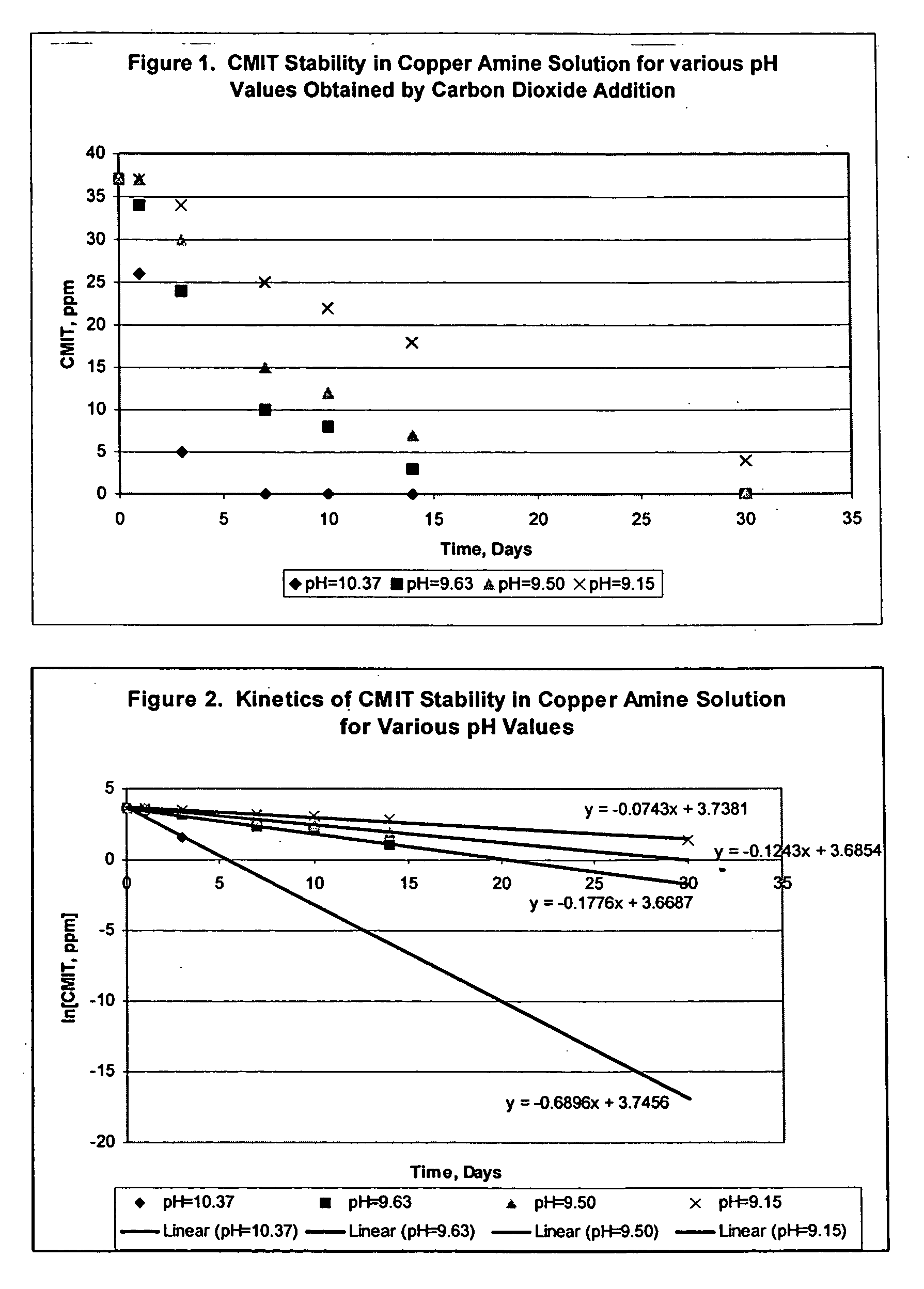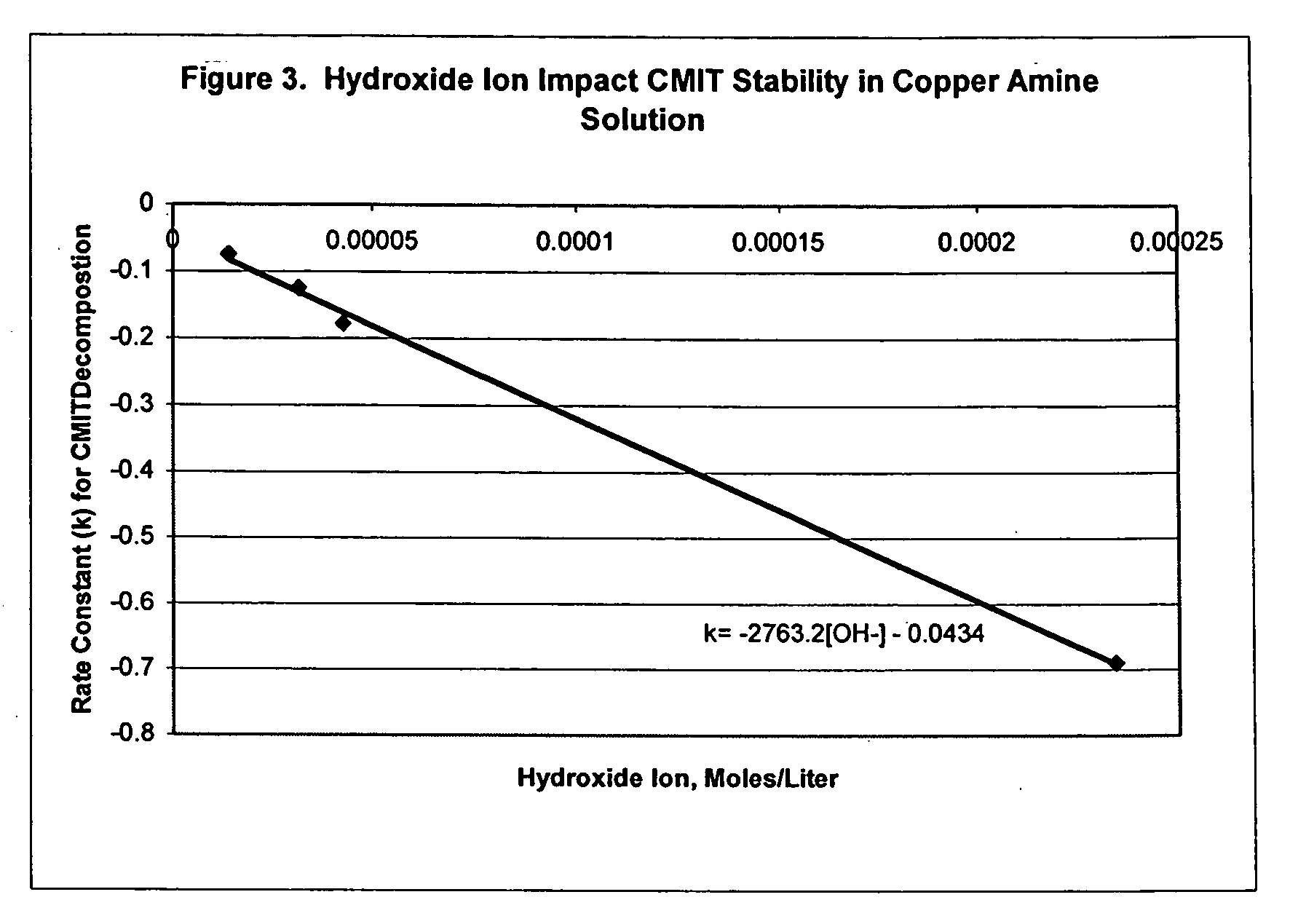Penetration improvement of copper amine solutions into dried wood by addition of carbon dioxide
a technology of copper amine and solution, applied in the field of impregnation of wood substrate, can solve the problems of degradation of some protectants, wood to become unsightly or emit unpleasant odor, subject to biological and chemical degradation, etc., and achieve good working range, improve the penetration of preservative solution, and reduce the effect of preservative penetration
- Summary
- Abstract
- Description
- Claims
- Application Information
AI Technical Summary
Benefits of technology
Problems solved by technology
Method used
Image
Examples
example 1
Improved Preservative Penetration
[0029]Eight Red pine 4×4 inch boards were cut into 4-inch long sections and a section from each board was assigned to a different preservative treatment. Each treatment was applied to all eight sections at the same time in the same pressure treatment cylinder. The Wolman E solution used for these treatments were: no additive (control); the solution containing the invention, carbon dioxide; ammonium bicarbonate; and ammonium hydroxide. Typically, ammonia containing preservatives penetrate the more refractory wood species, such as Red pine (Pinus resinosa); thus, both ammonium carbonate and ammonia were added to the Wolman E treatment solution and examined for preservative penetration in this study.
[0030]The ends of each section were sealed with epoxy to assure that the preservative solution entered through the sides of the samples. This simulates the treatment of large pieces of wood, where the preservative solution predominantly enters through the ra...
example 2
Penetration Improvement from Bicarbonate
[0036]Fifteen 12 foot 4×4 inch boards of Red pine were cut into 6 foot lengths and labeled “A” or “B”. The “A” halves were treated with a solution of Wolman E without additives. The “B” halves were treated with a similar Wolman E solution after adding 0.47% ammonium bicarbonate (equivalent to 0.26% CO2). Each treatment was applied to all fifteen sections at the same time in the same cylinder. The pressure treating process consisted of an initial vacuum of 24 inches Hg for 10 minutes, a 175-psi pressure period for 60 minutes, and a final vacuum of 24 inches Hg for 60 minutes. After treating, the boards were cut in half and the preservative penetration measured as percent of sapwood treated. Penetration values were averaged for the fifteen sections from each treatment. The results are shown in Table 2.
TABLE 2Penetration Improvement from Bicarbonate Using Commercial Cycles% Sapwood TreatedWolman E + 0.47%Wolman EAmmoniumSampleControlBicarbonate19...
example 3
Preservative Sapwood Penetration Improvements with Carbon Dioxide
[0038]Eight-foot ponderosa pine (Pinus ponderosa) 2×6 inch lumber was cut into 4 oott end-matched sections and sequentially labeled “A” or “B”. All of the “A” sections were treated with a Wolman E solution, containing 0.3% copper and no additives. This control treatment was applied in three charges containing 20 sections each. The pressure treating process consisted of an initial vacuum of 24 inches Hg for 10 minutes, a 175-psi pressure cycle for 60 minutes, and a final vacuum of 24 inches Hg for 10 minutes. After treating, the sections were cut open at the mid point of each board and the preservative penetration measured as percent of sapwood treated. The matched “B” sections for those “A” sections that had low penetration values were grouped into sets of six and treated with Wolman E, containing 0.3% copper and added 0.3, 0.4, or 0.8% carbon dioxide. The same pressure process was used for these sections. The resultin...
PUM
| Property | Measurement | Unit |
|---|---|---|
| weight ratio | aaaaa | aaaaa |
| weight ratio | aaaaa | aaaaa |
| pH | aaaaa | aaaaa |
Abstract
Description
Claims
Application Information
 Login to View More
Login to View More - R&D
- Intellectual Property
- Life Sciences
- Materials
- Tech Scout
- Unparalleled Data Quality
- Higher Quality Content
- 60% Fewer Hallucinations
Browse by: Latest US Patents, China's latest patents, Technical Efficacy Thesaurus, Application Domain, Technology Topic, Popular Technical Reports.
© 2025 PatSnap. All rights reserved.Legal|Privacy policy|Modern Slavery Act Transparency Statement|Sitemap|About US| Contact US: help@patsnap.com


